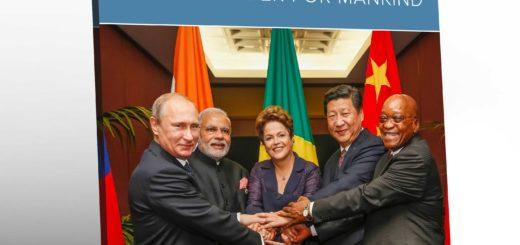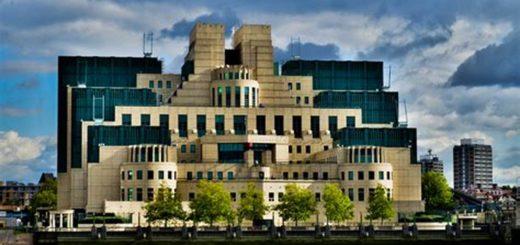|
WEDNESDAY, JANUARY 20, 2016 Volume 2, Number 106 EIR Daily Alert Service P.O. Box 17390, Washington, DC 20041-0390
EDITORIALChina and Russia Lead Growth; Obama and Wall Street Lead Death-SpiralJan. 19 (EIRNS)—As Obama continues to improve his kill rates—in addition to his weekly drone kills, you can now add Flint Michigan, Puerto Rico, and the overall national demographic death rates in the U.S.—it’s important to keep in mind “how the other half lives,” i.e., that half of humanity that is not enslaved to the British Empire, and is instead progressing under China-led BRICS economic policies. While the financial press ridiculously points to China as the “epicenter” of the ongoing international financial meltdown (supposedly because its GDP growth for 2015 was “only” 6.9%, a 25-year low), the reality is that it is the epicenter of growth. China’s Ambassador to Russia Li Hui gave an interview to Sputnik in which he emphasized that China-Russia cooperation is at the center of these economic policies. “Now, many countries are showing an active interest in the Silk Road Economic Belt initiative, multiple agreements and memorandums on bilateral and multilateral levels have been signed. Russia, as the largest neighbor and a strategic partner of China, is an important participant in the construction of the Silk Road, which has significant advantages,” Li said. He gave some specific examples: “Construction works have already begun in China to build the eastern string of the pipeline that has been dubbed the deal of the century by the media,” Li said. He also mentioned the high-speed rail line between Moscow and Kazan, which “has entered the stage of practical realization.” And overall there is “stepped up cooperation in building wide-body planes,” as well as on nuclear energy, electricity, chemical industry and production of natural resources, Sputnik reported Li saying. Chinese President Xi Jinping is now demonstrating what real diplomacy looks like, as well. While the British Empire is doing everything possible to provoke full-scale Sunni-Shi’a warfare in the Middle East, using its puppet regime in Saudi Arabia, Xi Jinping is visiting Saudi Arabia, Iran, and Egypt, starting today, to counter the British scheme, reminding both Saudi Arabia and Iran, which are both friends and leading trading partners of China, that peace through development is the only sane future, and that China’s Silk Road economic policies will help both in that direction. Can the U.S. wake up and join the New Silk Road, and save itself from the destruction of Wall Street and the British Empire? STRATEGIC WAR DANGERNATO Militarization of the Baltics: Like the Nazis before the InvasionJan. 19 (EIRNS)—A number of Russian military experts see the U.S. and NATO turning the Baltic countries into an armed camp; and what they see is a replay of the German build-up to the invasion of Russia in 1941. Like Nazi Germany then, NATO insists that its build-up is purely defensive and no threat to Russia. When asked about this, Ivan Konovalov, the director of the Center for the Study of Strategic Trends, a Moscow-based military think tank, told Svobodnaya Pressa bluntly: “Surely you must agree that it is difficult to see how Abrams tanks and artillery can be considered equipment with a purely defensive purpose? Russia was forced to respond because it reminded it of the situation in 1941, when the Germans moved large formations up to our borders, while simultaneously talking about their defensive nature.” Konovalov noted that, as a result of this NATO military build-up, Russia is redeploying forces internally, including three new ground forces divisions announced by Defense Minister Sergei Shoigu, last week, to cover the approaches from the Baltic countries. Konovalov also noted the presence of the current stockpile of B61 bombs in Europe—slated to be replaced by the modernized B61-12. “The same NATO planes which are now permanently patrolling Baltic airspace, flying near our borders, could be loaded up” with such weapons, he says. “Europe now has 200 such bombs. Accordingly, the 16 aircraft at the bases at Zokniai, Lithuania, or Amari, Estonia, can carry them onboard. And the pilots of these countries have been trained on how to use such weapons.” Again on the Russian response, veteran defense commentator Viktor Litovkin compares the NATO military build-up in the Baltics to having a stone in your shoe: very small but so irritating that eventually you have to do something about it. “This NATO ‘stone in our shoe’ will force Moscow to react. And the U.S. is actively trying to provoke another arms race in order to weaken our country economically,” he said. And the three new divisions are but a small part of what Russia will do to remove the stone in its shoe. Russia Has Changed the Dynamic in SyriaJan. 19 (EIRNS)—It seems that every day there is further confirmation of how the Russian military intervention in Syria has reshaped the war on the ground. The latest example of this is a Jan. 18 article in the Los Angeles Times, titled “Backed by Russian Air Power, Syria’s Army Builds on Gains.” Author Nabih Bulos takes note of the recent advances made all over the country, from Latakia and Aleppo in the north to Daraa in the south and Deir Ez Zor in the east. “Even Islamic State, whose fighters are regarded as some of the fiercest in the conflict, appears to be on its back foot,” Bulos writes. “Assad is winning. Russian air power [has] changed the entire dynamic of what’s going on, and it just gives the Syrian army an incredible boost,” Joshua Landis, director of the Center for Middle East Studies at the University of Oklahoma, told the Times. He noted that Moscow’s air campaign appears to be gaining effectiveness as Russian commanders grow more familiar with the conflict and with the capabilities of allied Syrian ground forces, observers say. “What I’m hearing from Damascus is that it has taken time to digest the new technology, for the Russians to get well situated, get the intelligence they require and know what they’re doing,” Landis said. U.S. POLITICAL AND ECONOMICU.S. East Coast Targeted with Bomb Threats against SchoolsJan. 19 (EIRNS)—Since the bomb and mass-shooting threats that put New York City on alert and shut down all Los Angeles public schools Dec. 15, the strategy-of-tension operations aimed at the nation’s schools have intensified. Those threats came less than two weeks after the deadly attacks in San Bernardino. Today, terror threats have forced the shutdown of elementary schools and high schools in Delaware, Massachusetts, and New Jersey. Do you think they may be coordinated? Schools in Delaware, Maryland, and Virginia region were evacuated this morning, and eventually cleared to reopen after they had been searched. It’s the second week in a row that bomb threats have targeted Delaware schools. The Delmarva Daily Times mentioned eight schools that had been targeted. The Times quoted a Delaware State Police Department release which stated a caller threatening one school, Long Neck Elementary, said he was on the roof of the school, armed, and intending to harm pupils and faculty. In Massachusetts, several high schools received bomb threats this morning. The Boston Globe reported that police said that Arlington High received a “robocall” stating that a bomb would be detonated, and that students would be shot as they fled. School was dismissed. “We are doing a controlled release,” Arlington Police Chief Frederick Ryan told the Globe. “We are sheltering in place while we are releasing students by [building] assignment.” The other Massachusetts schools were evacuated, pending their being searched. In northern New Jersey, at least nine schools had to be evacuated or put on lockdown this morning, after receiving threats of bombs and a mass shooting. Obama Denounced as ‘Deporter in Chief’Jan. 19 (EIRNS)—The Obama regime has formally deported (“removed”) well more than 2 million individuals in its first seven years, and it has a backlog of hundreds of thousands more that it is attempting to deport. Beyond that are millions more who have been “returned,” reports Vox. (The latter is a less formal process. The former, conducted by Immigration and Customs Enforcement, makes the immigrant a felon if he returns.) Obama officials are trying to justify their actions by claiming that it is for the immigrants’ own good: “The goal of this effort is to provide a safe and legal alternative to the dangerous journey many are currently taking in the hands of human smugglers,” White House spokesman Peter Boogaard told today’s Washington Post. Other U.S. officials said the operations are aimed at sending a strong message of deterrence to Central American families, and avoiding a repeat of the 2014 border crisis when an influx of tens of thousands of migrants from the region overwhelmed patrol stations on the Mexican border. Homeland Security (DHS) officials say they are also considering expanding the raids to include minors who entered the country on their own. A group of 140 House Democrats sent a letter to Obama last Tuesday on the day of his State of the Union address, demanding that the raids be stopped. Sen. Robert Menendez (D-N.J.) has since called on the regime to “immediately halt domestic immigration raids that fast-track the deportations of the very same families we are hoping to aid.” COLLAPSING WESTERN FINANCIAL SYSTEMOil Meltdown: This Is Just the BeginningJan. 19 (EIRNS)—As the price of oil slid further today, to just under $28 per barrel, Standard Chartered bank had a confession to make: “Prices are being moved almost entirely by financial flows.” Among the casualties are major banks, which have been instructed by the Dallas Federal Reserve to lie by not marking-to-market the value of oil company debt they are holding. (If they did, half the U.S. oil sector would go up in smoke, and very possibly take with it a half-dozen major banks and their derivatives positions to boot.) Another casualty are the Saudi and other Gulf sovereign wealth funds, which hold $2 trillion in assets—largely U.S. and other western treasury securities. These funds, according to U.S.A. Today, are now being subjected to a “selling spree,” which could produce a financial tsunami in the markets. Saudi sovereign bonds are already rated at the level of Portuguese bonds, i.e., quite low. The oil meltdown is also wreaking havoc on the Houston real estate market, in particular, with December sales down 10% from a year earlier, and third quarter housing permits down 26%. EU Officials Move To Crush Sovereign DebtJan. 19 (EIRNS)—Dutch Finance Minister Jeroen Dijsselbloem, president of the Eurogroup of euro area finance ministers, and Andreas Dombret, Bundesbank representative on the ECB board, came out separately today pushing for a downgrading of sovereign bonds held by Eurozone banks. This is the proposal contained in the draft paper submitted to the Bundestag by Deputy Finance Minister Jens Spahn in December. It would force many southern banks, especially in Italy, to pay higher interest rates and dramatically increase their reserve requirements. It reveals the intention to crush the nations that stand behind that sovereign debt. “We need a more realistic regulatory treatment of the risks of the government bonds that banks hold. The crisis has clearly shown that such exposures are not risk-free,” Dijsselbloem wrote in an op-ed for the Wall Street Journal, Jan. 18. “Given the painful experience of the last six years, it has become more than obvious that sovereign paper is not risk-free,” Dombret was quoted as saying by Bloomberg. “From my point of view, this is an issue which needs to be finalized, possibly after the Basel III reforms,” he said in a Jan. 18 interview with media, headlined “Forget Basel IV: Bundesbank Says Beware of Banks’ Sovereign Risk.” Dijsselbloem also defended the bail-in regime—after all, he first coined the phrase “Cyprus template” to propose universalizing such expropriations of citizens’ savings to bail out speculators—and called for speeding up the process leading to a capital-markets union to set the standard for “simple and transparent securitizations.” As we have reported, a capital-markets union would replace bank credit as a source of financing for small and medium companies. In reality, it will force community banks to close or merge into investment banks, confront firms with costly bond emissions which most of them cannot afford, and channel family savings into the gambling economy. Conflict between EU and Italy EscalatesJan. 19 (EIRNS)—Heated words between Rome and Brussels escalated yesterday when EU Commission President Jean-Claude Juncker publicly scolded the Italian government for complaining too much about the EU Commission. Prime Minister Matteo Renzi promptly responded to Juncker, stating that Italy will not be “steered from outside.” Today, the polemics escalated when Manfred Weber, European Parliament chair of the European People’s Party (Christian Democrats), accused Renzi of “jeopardizing the strength and the international credibility” of the EU. Behind the verbal escalation there is a real conflict on how to deal with the Italian banking crisis. Rome wants to create a bad bank for the bad loans in the banking system (between €200-400 billion), and use the government-sponsored Cassa Depositi e Prestiti as a guarantor. Brussels says: Okay, but no government guarantees. Meanwhile, the run on Italian banks from fear of a bail-in has intensified, and some believe that this is the result of a speculative attack. Banca Monte dei Paschi di Siena (MPS) bank has now lost more than one-third of its equity value. In reality, Renzi does not challenge the bail-in regime, but wants to speed up the implementation of the capital markets union. A showdown is planned for Jan. 29, when Renzi will meet Germany’s Chancellor Angela Merkel in Berlin. Puerto Rican Crisis Deepens, But Wall Street Demands BloodJan. 19 (EIRNS)—In a briefing to reporters yesterday, Puerto Rican government officials presented revised figures indicating that the island’s financial and humanitarian crisis has dramatically worsened in just the past few months, with shrinking tax revenues and a gaping deficit that continues to balloon. The deficit projection for the next five years has already been revised upward by 15%, from $14 billion to $16 billion, and is anticipated to go to $23 billion or higher over the next ten years, as neither the population nor the economy can sustain more austerity than what has already been imposed. That doesn’t bother Wall Street, whose representatives insist Puerto Rico is “exaggerating” the depth of its crisis and can still squeeze more blood out of its impoverished people. U.S. Treasury Secretary Jack Lew will arrive in Puerto Rico tomorrow to discuss the crisis with government officials, and while he has called for Congress to pass legislation to grant Chapter 9 bankruptcy protection to the Commonwealth, he also backs a Republican Party proposal to establish a financial control board, whose job would be to enforce even more brutal austerity. Perhaps next, Obama will be offering 3 million Puerto Ricans “Kool-Aid” from Michigan’s deadly Flint River. The government has no cash, officials underscored. Tax revenues are $500 million lower than forecast, and by June, Bloomberg reported, the government faces a $923 million negative cash balance. In the second half of 2015, the government cut social insurance programs, delayed $330 million in tax refunds due people since 2014, and stopped paying vendors, who are now owed $1.8 billion in back payments. Unless they are paid quickly, vendors will stop providing medical supplies to hospitals, food to prisons, and other essential public services. In May, a $400 million debt payment comes due, and then $2 billion more on July 1. Without any debt relief, officials warn, there will be defaults on July 1 “from the top to the bottom of the hierarchy of creditors.” On Jan. 22, government officials will hold a conference call with creditors’ advisors to discuss their revised figures as well as a comprehensive restructuring proposal, according to Melba Acosta, head of the Government Development Bank. Davos Head Schwab: The Oil Crisis Could Produce 1 Billion Refugees from Middle East, North AfricaJan. 19 (EIRNS)—On the eve of the annual Davos World Economic Forum (WEF), which will pull together 2,500 economic and political “leaders” of the dying trans-Atlantic system, WEF head Klaus Schwab presented his doomsday plan, on behalf of the British Empire. Schwab warned that the refugee crisis inundating Europe in 2015 is nothing compared to what’s coming: “Look how many countries in Africa, for example, depend on the income from oil exports. Now imagine 1 billion inhabitants, imagine they all move north.” This could lead to “a substantial social breakdown,” he noted. Social breakdown and massive depopulation is the intended result of the British Empire’s policy, for which Schwab is a front-man. Contrary to what many had predicted, migration to Germany from war-torn Syria and other countries has continued during the winter months. Reuters cited an unnamed senior German official saying: “You can only imagine what happens when the weather improves…. We have until March, the summer maybe, for a European solution” to the refugee problem, or the entire EU could disintegrate. Already there has been a dramatic increase in migration to Germany from the North African countries of Morocco and Algeria, which has increased fivefold since July 2015. In each of the months of November and December, more migrants came from these two countries than in the entire year of 2014. Algeria is precisely one of those countries described by Schwab: it depends on oil and gas exports for 97% of its export earnings. China has a very different approach to the problem as EIR Daily Alert reported yesterday: development, and integration with the New Silk Road. On Jan. 18 China and Algeria signed a deal for a new $3.3 billion port complex at Cherchell, 55 miles west of Algiers. THE NEW GLOBAL ECONOMIC ORDERXi Jinping To Visit Saudi Arabia, Iran and Egypt: Bringing Peace through the New Silk RoadJan. 19 (EIRNS)—Chinese President Xi Jinping has begun a five-day swing through Saudi Arabia, Iran, and Egypt whose intention is to fully turn the tables on London’s policy of bloody sectarian warfare and terrorism in the region. His main instrument is China’s “win-win” policy of bringing the One Belt, One Road program to the remotest corners of the planet. Xi Jinping stated the policy in an article he wrote for the Kingdom’s principal daily Al Riyadh on the eve of his Jan. 19 arrival there. The Egypt leg of the trip will be particularly important, with Xi to deliver a major policy speech before the Arab League, headquartered in Cairo. Multibillion-dollar deals and investment agreements are scheduled to be signed between China and Egypt, including a memorandum of understanding for Egypt to participate in China’s One Belt, One Road economic cooperation policy. Other areas will include cooperation in infrastructure, nuclear power, so-called “new energy,” aviation, finance, and other sectors, according to the BRICS Post. Egypt’s ambassador to Russia Magdy Amer, told Egypt’s MENA news service that during Xi’s visit deals will also be signed for $1.8 billion in loans: $1 billion to strengthen Egypt’s foreign reserves; $700 million to the National Bank of Egypt to finance projects; and $100 million to Banque Misr for small and medium-sized business projects. A senior intelligence source in Washington, D.C., reported that China is in a unique position to defuse the British sectarian warfare plan in the area, having not “taken sides” between Iran and Saudi Arabia in the recent period. Egypt can also play a key role, the source said, since it has not sunk into the sectarian conflict affecting much of the region. The Eurasian Land-Bridge after One Year—Trade ExplodesJan. 19 (EIRNS)—Although China’s trade fell this year overall, in dollar terms, Xinhua reports today on the extensive new trade facilitated by the new “Eurasian Land-Bridge” rail routes from China to Europe. “For the whole of 2015, China’s total export and import values continued decreasing by 7% year on year, falling for the first time in six years. However, Yiwu’s [in the coastal province of Zhejiang, the terminus of a Land-Bridge line] small commodity center witnessed a surge of 46.2% year on year in its foreign trade volume, hitting $25.66 billion in the first three quarters of 2015,” they write. This route, called Yixin’ou in Chinese (Yiwu-Xinjiang- Europe), at 13,052 km, is the longest train route in the world, Xinhua reports, cutting travel time to one-third that of shipping and cutting costs to one-fifth that of air freight. “Over the past year, 17 trains carried 794 TEU containers to Europe. Three trains sent 146 TEU containers of imported goods back.” Meanwhile, the northern route from Harbin (in Heilongjiang in the Northeast) to Hamburg through Russia and Poland, transported $87 million worth of goods in the second half of 2015 after the service was launched in June. The 15-day trip, covering 9,820 km, carries goods from China, the Republic of Korea and Japan to European countries including Germany, Poland, France, Spain and Italy. The west-bound cargo is mostly electronics and auto parts, while China now enjoys “beer from Germany, ham from Spain, pizza from Italy as well as industrial products and daily necessities [which] have become more accessible to ordinary Chinese,” said Cheng Yao, vice head of the economic research institute of the Heilongjiang provincial academy of social sciences. Xinhua adds that the Land-Bridge “also assisted China’s manufacturing firms in expanding overseas business along the rail line.” SCIENCE AND INFRASTRUCTUREIran Is Ready To Move from Fission to Developing FusionJan. 19 (EIRNS)—Former Iranian President Ali Akbar Hashemi Rafsanjani told Mehr News Agency on Jan. 18 that Iran has achieved success in fission nuclear science, but that this is an old technology. “Thanks to normalization of the country’s nuclear activities, Iran can pursue more advanced technologies. We have good achievements at the Amirkabir University of Technology and Islamic Azad University, in [the] nuclear fusion sphere,” he said. Azad University is a private institution that was established by Rafsanjani. The founder of the Azad University fusion program was interviewed in the Sept. 18, 2015, issue of EIR. “It is expected that the first fusion-based nuclear reactor will be constructed soon,” said Rafsanjani. Recall that the July nuclear agreement includes potential Iranian contributions to the international ITER fusion project under construction in France. |
|
|















